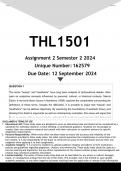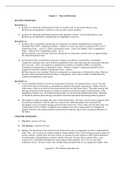Tentamen (uitwerkingen)
THL1501 Assignment 2 (ANSWERS) Semester 2 2024 - DISTINCTION GUARANTEED
- Vak
- Instelling
- Boek
Well-structured THL1501 Assignment 2 (ANSWERS) Semester 2 2024 - DISTINCTION GUARANTEED. (DETAILED ANSWERS - DISTINCTION GUARANTEED!).. Question 1: In her book, Basic Issues in Aesthetics (1998), cited in the Study Guide, Marcia Eaton discusses the difficulties with defining the terms “beauty�...
[Meer zien]













